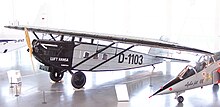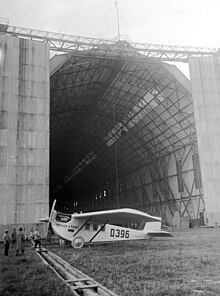Dornier Komet
| Komet, Merkur, and related | |
|---|---|

| |
| Dornier B-Bal "Merkur" of Ad Astra Aero S.-A. | |
| Role | Airliner |
| Manufacturer | Dornier Flugzeugwerke |
| First flight | 1921 |
The Dornier Komet, Merkur, Do C, Do D, and Do T were a family of aircraft manufactured in Germany during the 1920s, originally as small airliners, but which saw military use as well. The earliest aircraft in the series were basically landplane versions of the Delphin flying boat, and although the Delphin and Komet/Merkur series diverged from each other, design changes and refinements from one family were often incorporated into the other.
Design and development
The first Komets (Do C III Komet I) utilised the wing, tail, and even upper fuselage of the early Delphin versions, but replaced the lower fuselage and sponsons with a simple sheet-metal bottom that incorporated fixed tailskid undercarriage. The engine installation was also relocated from its peculiar position above the Delphin's nose to a conventional location in the Komet's fuselage nose. Accommodation was provided for a single pilot and four passengers. An improved version, the Do Komet II, was first flown on 9 October 1922 and was widely exported to countries including Colombia, Spain, Switzerland, and the Soviet Union.


The Do Komet III of 1924 was a practically all-new design that shared many elements with the Delphin III. The cabin was expanded to seat another two passengers, and the wing was raised above the fuselage on short struts. This version was exported to Denmark and Sweden, but was also produced under licence in Japan by Kawasaki.
In 1925, the Komet III was replaced in production by the Do B Merkur I, which featured a revised fin and longer-span wings. When fitted with the BMW VI engine, it became known as the Do B Bal Merkur II, as did indeed any Komets thus re-engined. The type was widely used by Deutsche Luft Hansa, which had some 30 Merkurs operating at one time, and was also exported to Brazil, China, Colombia, Japan, and Switzerland.
The Do C and Do D were follow-on military designs, the former a trainer exported to Chile and Colombia, the latter a floatplane torpedo-bomber built for the Yugoslav Royal Navy. The designation Do T was used for a landplane ambulance version.
Variants
- Do C III Komet I
- First of the Komet series
- Do Komet II
- Do Komet III
- Do B Merkur I
- Do B Bal Merkur II
- Do C
- Military version of the Komet III
- Do C-1: Twin-seat fighter.
- Do C-2A: Recognition version.
- Do C-3: Recognition version.
- Do C-4: Do-10, development of C-1.
- Do D
- A much revised floatplane torpedo bomber version for the Royal Yugoslav Air Force
- Do T
- An ambulance version
Operators
Civil operators
Military operators
Specifications (Merkur II)

Data from [citation needed]
General characteristics
- Crew: 2, pilot and mechanic
- Capacity: 8 passengers
Performance
Notes
This article includes a list of references, related reading, or external links, but its sources remain unclear because it lacks inline citations. (July 2011) |
References
- Taylor, Michael J. H. (1989). Jane's Encyclopedia of Aviation. London: Studio Editions. p. 327.
- World Aircraft Information Files. London: Bright Star Publishing. pp. File 892 Sheet 26.
External links
